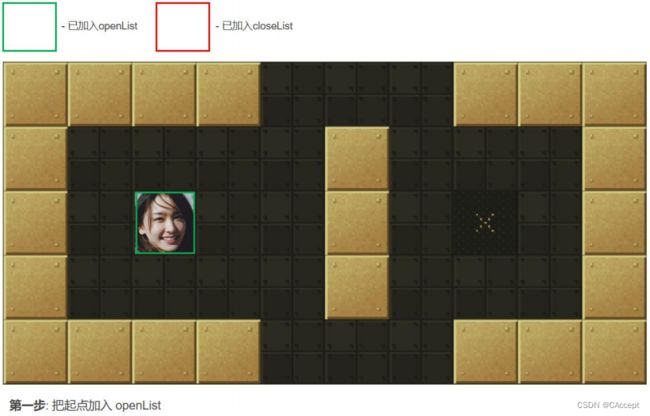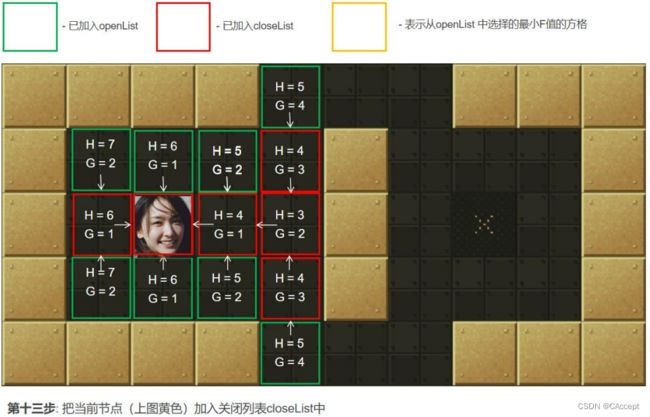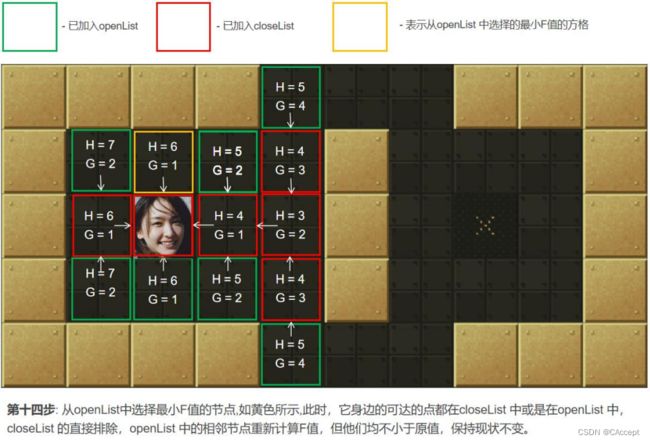AI自动寻路AStar算法【图示讲解原理】
文章目录
- AI自动寻路AStar算法
-
- 背景
- AStar算法原理
- AStar寻路步骤
- AStar具体寻路过程
- AStar代码实现
- 运行结果
AI自动寻路AStar算法
背景
AI自动寻路的算法可以分为以下几种:
1、A*算法:A*算法是一种启发式搜索算法,它利用启发函数(heuristic function)来评估节点的估价函数(estimated cost function),从而寻找最短路径。A*算法综合考虑了节点的实际代价和到目标节点的预计代价,因此能够快速而准确地寻找最短路径【不一定最短,A*算法并不一定能够找到最短路径,但它通常可以找到接近最短路径的解决方案。】
2、Dijkstra算法:Dijkstra算法是一种贪心算法,它从起点开始,每次选择当前代价最小的节点作为下一个节点。通过不断更新节点的代价,最终可以找到起点到终点的最短路径。
3、Bellman-Ford算法:Bellman-Ford算法是一种动态规划算法,它通过不断更新节点的代价,直到收敛到最短路径。相比于Dijkstra算法,Bellman-Ford算法能够处理负权边的情况。
4、Floyd-Warshall算法:Floyd-Warshall算法是一种动态规划算法,它能够计算出图中任意两点之间的最短路径。Floyd-Warshall算法通过不断更新节点之间的代价,直到收敛到最短路径。
这些算法都可以用于AI自动寻路,具体选择哪种算法需要根据具体的应用场景和性能要求进行选择。
随着 3D 游戏的日趋流行,在复杂的 3D 游戏环境中如何能使非玩家控制角色准确实现自动寻路功能成为了 3D 游戏开
发技术中一大研究热点。其中 A*算法得到了大量的运用,A*算法较之传统的路径规划算法,实时性更高、灵活性更强,寻路
结果更加接近人工选择的路径结果. A*寻路算法并不是找到最优路径,只是找到相对近的路径,因为找最优要把所有可行
路径都找出来进行对比,消耗性能太大,寻路效果只要相对近路径就行了。
所以对于自动寻路,A*算法是一个很不错的选择!!!
AStar算法原理
我们假设在推箱子游戏中人要从站里的地方移动到右侧的箱子目的地,但是这两点之间被一堵墙隔开。

我们下一步要做的便是查找最短路径。既然是 AI 算法, A* 算法和人寻找路径的做法十分类似,当我们离目标较远时,我
们的目标方向是朝向目的点直线移动,但是在近距离上因为各种障碍需要绕行(走弯路)!而且已走过的地方就无须再次
尝试。
为了简化问题,我们把要搜寻的区域划分成了正方形的格子。这是寻路的第一步,简化搜索区域,就像推箱子游戏一样。
这样就把我们的搜索区域简化为了 2 维数组。数组的每一项代表一个格子,它的状态就是可走 (walkalbe) 和不可走
(unwalkable) 。通过计算出从起点到终点需要走过哪些方格,就找到了路径。一旦路径找到了,人物便从一个方格的中心
移动到另一个方格的中心,直至到达目的地。
简化搜索区域以后,如何定义小人当前走要走的格子离终点是近是远呢?我们需要两个指标来表示:
1、 G 表示从起点移动到网格上指定方格的移动距离 (暂时不考虑沿斜向移动,只考虑上下左右移动)。
2、 H 表示从指定的方格移动到终点的预计移动距离,只计算直线距离 (H 有很多计算方法, 这里我们设定只可以上
下左右移动,即该点与终点的直线距离)。

令 F = G + H ,F 即表示从起点经过此点预计到终点的总移动距离
AStar寻路步骤
1、从起点开始, 把它作为待处理的方格存入一个预测可达的节点列表,简称 openList, 即把起点放入“预测可达节点列表”,可达节点列表 openList 就是一个等待检查方格的列表。
2、寻找 openList 中 F 值最小的点 min(一开始只有起点)周围可以到达的方格(可到达的意思是其不是障碍物,也不存在关闭列表中的方格,即不是已走过的方格)。计算 min 周围可到达的方格的 F 值。将还没在 openList 中点放入其中, 并设置它们的"父方格"为点 min,表示他们的上一步是经过 min 到达的。如果 min 下一步某个可到达的方格已经在 openList列表那么并且经 min 点它的 F 值更优,则修改 F 值并把其"父方格"设为点 min。
3、把 2 中的点 min 从"开启列表"中删除并存入"关闭列表"closeList 中【当自己对四周扩散时,将自己放入到closeList中】, closeList 中存放的都是不需要再次检查的方格。如果 2 中点 min 不是终点并且开启列表的数量大于零,那么继续从第 2 步开始。如果是终点执行第 4 步,如果 openList 列表数量为零,那么就是找不到有效路径。
4、如果第 3 步中 min 是终点,则结束查找,直接追溯父节点到起点的路径即为所选路径。
AStar具体寻路过程
AStar代码实现
Astar.h
#pragma once
#include
//链表
#includeAstar.cpp
#include"Astar.h"
#includemain.cpp
#include

















